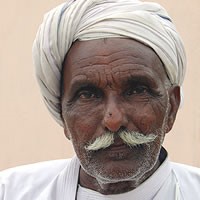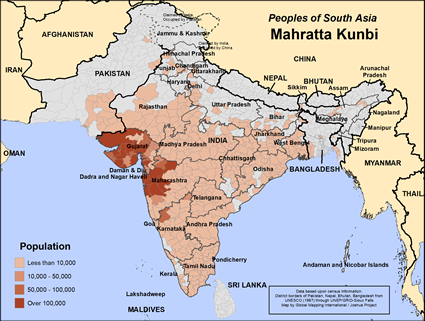The Mahratta Kunbi people group was originally a Marathi speaking people, but now Gujarati is also a prominent language. The word "kunbi" is a derivation from the Sanskrit word "Kutumbin" or "householder". There is often confusion about the distinction between the Mahratta people group and the Mahratta Kunbi people group. The primary distinction is in wealth and a common origin is assumed between the two groups. The Mahratta people group tends to have come from chieftain and warrior heritage, while the Kunbi people group is primarily farmers. Both people groups are the dominant caste in the Maharashtra state and make up about half of the population. The fact that the Mahratta and Mahratta Kunbi people groups often intermarry is further evidence for their common origins and an argument for them being one people group.
The Mahratta Kunbi people group is primarily located within the Maharashtra and Gojarat states. Smaller populations can be found throughout India and also in Pakistan by the India-Pakistan border. Since the state of Maharastra is one of the more urban regions in India, many Mahratta Kunbis have migrated towards urban communities, but the majority still live in rural villages.
The Mahratta Kunbis primarily live as farmers in villages. They often own small houses and work animals to assist in cultivating their farms. Many Kunbis are also traders, soldiers, or work in the government service. The Mahratta Kunbi people group practices arranged marriages often at an early age. A dowry is also common amongst the arrangements. Coming from a higher social class, the Mahratta Kunbis do not face discrimination, but have opportunities for social advancement though they are still primarily a part of the lower-income groups in India.
Due to their heavy dependence on farming, agricultural festivals are an important part of life as a Mahratta Kunbi. The cattle owned by families are often the centerpieces of these festivals and families take great pride in their ownership.
The Mahratta Kunbis are a vastly Hindu people group with little or no other religious affiliations. They worship the god Shiva and other gods and their various incarnations, such as Vishnu and Devi. A temple is commonplace amongst villages and central to the many life cycle celebrations that are associated with Hinduism, such as at birth, marriage, and death. The temple priest is often from the Brahmin class.
As they still tend to be poor, the Mahratta Kunbis need economic justice. Specifically as farmers, the Mahratta Kunbi could use more efficient farming techniques, better seeds, and advanced farming technology. There are also many health problems associated with poverty and healthcare is necessary throughout most of the state of India.
Access to financial and other economic services is also limited in many of the regions that the Mahratta Kunbi live in. Women also live restricted lives and social justice is an important issue throughout India.
God would raise missionaries with a heart to serve the Mahratta Kunbi people group.
God would create the seeds of social change for women and economic development for all Mahratta Kunbis.
God would move in the hearts of the Mahratta Kunbi people and that they would respond positively to the Gospel.
Scripture Prayers for the Mahratta Kunbi in India.
| Profile Source: Levi Boxell |











